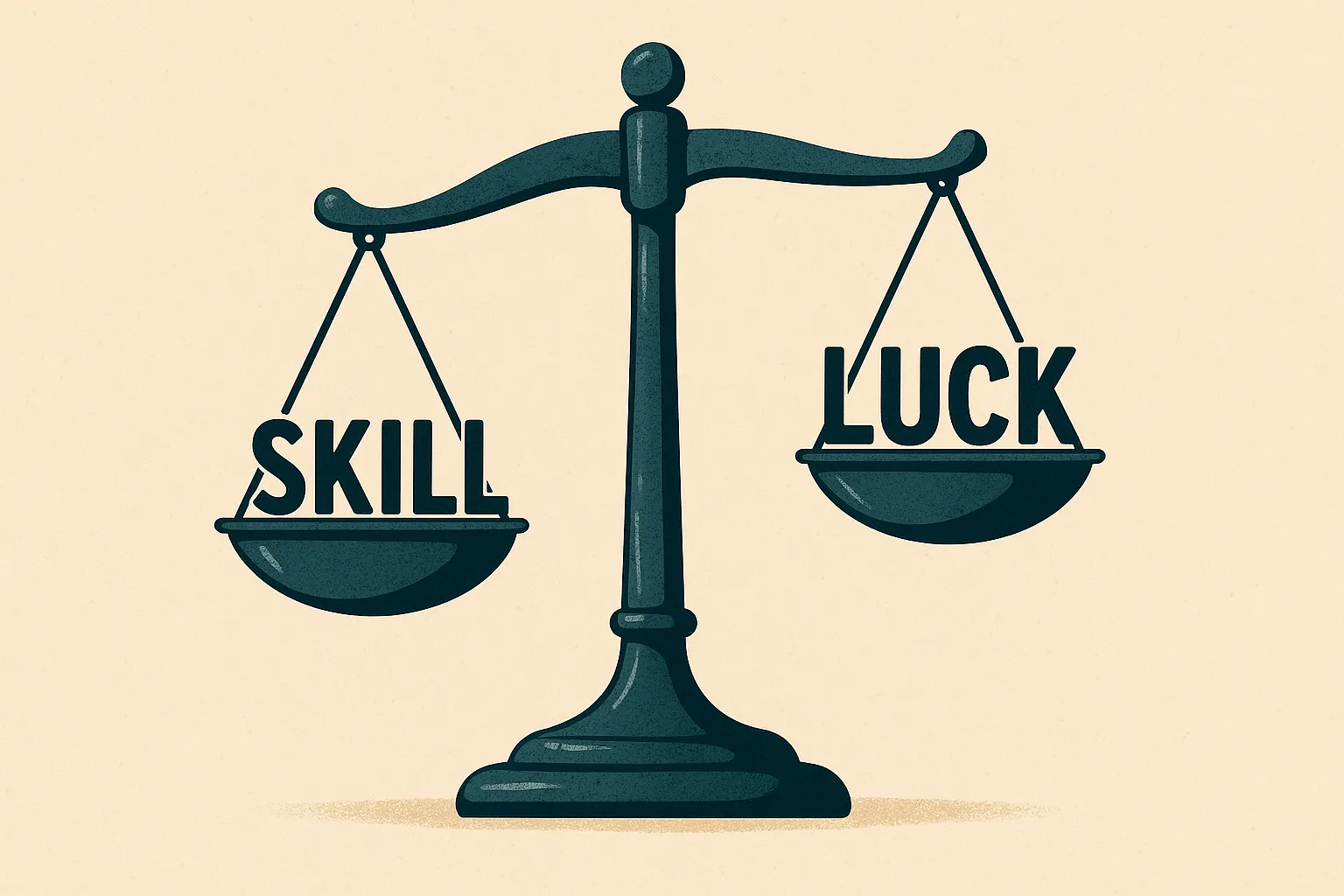Summary
Self-attribution bias leads investors to credit success to their skill and blame failures on luck or external factors. This distorts learning and inflates confidence. Overcoming it requires humility, journaling, comparing performance to benchmarks, and seeking feedback helping investors stay grounded, learn from mistakes, and make more rational decisions.
One of the most damaging patterns in investing isn’t what we believe about the market.
It’s what we believe about ourselves.
So, when we make a winning investment, we often quietly assume we’re a genius, yet when an idea goes sour, we believe we got unlucky and blame the market or some outside factor.
If you think this has applied to you sometime in the past, welcome to the world of Self-Attribution Bias. This is a common psychological pitfall in investing (and life) where we credit our successes to our skill and intelligence but blame failures on bad luck or others.
In simple words, self-attribution bias (a form of self-serving bias) describes our tendency to attribute positive outcomes to our own skill or actions, while attributing negative outcomes to external factors beyond our control. In everyday life, it’s the student who aces an exam and says “I worked hard, I’m brilliant,” but when they flunk a test, complains the questions were unfair. We all do this to some extent: a CEO might credit their leadership for high profits and then blame a weak economy when earnings dip (most management reports smell of this), or a sports coach may laud their strategy after a win and fault the referees after a loss. The pattern is the same: success has me to thank, while failure was beyond my control.
This bias shows up especially in investing. When our portfolio is up, we pat ourselves on the back for being savvy; when it’s down, we find excuses – “the RBI’s policies hurt my stocks,” “that analyst’s bad tip cost me money,” and so on.
There’s even a stock market adage capturing this idea: “Never confuse brains with a bull market.” In other words, a rising market can make any investor look like a genius. For example, an investor might enjoy big gains during a broad market rally and attribute those profits entirely to their stock-picking prowess, ignoring that a booming market lifted most stocks across all sectors and that many other investors had similar gains. Later, if their picks start tanking, the same investor might insist “Nobody could have seen this coming” or blame market volatility instead of their own decisions.
But Why Do We Do It?
On a psychological level, self-attribution bias stems from our need to protect our ego and self-esteem. Subconsciously, we all prefer to view ourselves as competent and capable. Attributing successes to our talent feels good and reinforces that positive self-image, whereas admitting mistakes or lack of skill feels threatening.
Psychologists note that we often make these skewed attributions without even realising it as a defense mechanism to maintain a positive self-image or boost self-esteem. In simpler terms, we want to believe we’re smart investors when things go right, and we don’t want to feel foolish when things go wrong.
Now, this bias isn’t a new discovery; it’s been documented in psychology research for decades. In a classic 1975 study, researchers Dale Miller and Michael Ross observed this “self-serving” attribution pattern: when people’s expectations were met with success, they tended to credit internal factors (their own judgment or skill), but when outcomes fell short of expectations, they blamed external factors.
This bias often goes hand-in-hand with overconfidence. By attributing a few successful investments to our own brilliance, we start to believe we really have a special knack for picking winners. Our confidence grows, sometimes unwarrantedly. We might double down on the next investment or take on bigger risks, convinced that we know what we’re doing (after all, look at those past wins we achieved!).
Meanwhile, any losses are brushed aside as “not my fault”, which means we don’t properly learn from our mistakes. Over time, this creates a skewed self-perception where we think we’re better investors than we truly are.
Even professional fund managers aren’t immune: they too can fall into the trap of believing their own skill explains every success, which can inflate their self-confidence. This is why self-attribution bias is sometimes called a “self-enhancing” bias. It fools us into enhancing our view of our own abilities, often beyond what reality justifies.
How to Recognise and Mitigate Self-Attribution Bias
Awareness is the first step to overcoming self-attribution bias. Here are some practical strategies I can think of that can help you keep this bias in check and make more rational investing decisions:
-
Keep a Decision Journal: Journaling is the antidote to all our biases, including this one. Maintain a log of your investment decisions, including why you bought or sold something, and later record the outcome. This habit forces you to confront the real reasons for your wins and losses. Over time, you might discover, for example, that a stock you thought you “knew” would soar actually went up due to a market rally, or that your losing investment had warning signs you overlooked. By reviewing a journal, you’ll likely find that you were right far less than you thought, and that your favourable outcomes were either due to luck or market-wide forces. A written record makes it harder to rewrite history in your favour and helps you learn from mistakes.
-
Compare Results to the Market: While I am in favour of absolute long term returns and not relative, it sometimes pays to compare your performance to the broader market’s. Whenever you evaluate your performance, check it against a relevant benchmark (such as the BSE-Sensex or a Total Returns Index). If your portfolio rose 10% but the overall market was up 15%, that’s a sign that market factors, not just skill, played a big role in gains (and that your strategy may actually have underperformed). Keeping perspective with a baseline can ground your attributions: you’ll be less likely to claim brilliance during bull markets or to feel unduly cursed during bear markets. Always ask, “Did I beat the market because of my choices, or was the whole market lifting me up?”
-
Ask Yourself Hard Questions: To recognise this bias in real time, pause and critically examine your reactions to outcomes. For any big gain, ask: “What external factors might have helped this succeed?” For any loss: “What was my role in this? What could I have done better?” If you find you immediately credit your intelligence for gains but have a long list of excuses for losses, that’s a red flag.
-
Acknowledge Luck: Make it a habit to admit the role of luck and randomness in investing outcomes. Even great investors are the first to say that not every win is purely skill. By explicitly acknowledging when favourable market conditions or plain chance contributed to your success, you keep your ego in check. For example, instead of saying “I made a killing on that stock,” you might note “that sector has been on fire, and I was in the right place at the right time.” Likewise, accept that sometimes you’ll make the right decision and still lose money due to unpredictable events. That’s part of investing. Adopting this mindset of humility can prevent the ego inflation that feeds self-attribution bias.
-
Seek External Feedback: It can help to get an outside perspective on your investing choices. Talk to a trusted financial mentor, advisor, or even a savvy friend about your wins and losses. They might point out external factors or holes in your logic that you overlooked. Sometimes just discussing your reasoning out loud reveals when you’re giving yourself too much credit. The key is to break out of your own echo chamber. An external observer may more readily call out, “Are you sure that gain wasn’t mostly due to the market rally?” or “Perhaps your thesis had a flaw you’re not acknowledging.” Actively seeking critique and contrary opinions can counteract our natural self-serving narrative.
Conclusion
Self-attribution bias is a natural human tendency. We all like to feel responsible for our triumphs and absolved of our failures.
In the arena of investing, however, this bias can be particularly dangerous. It lulls us into overestimating our abilities, encourages risky overconfidence, and keeps us from learning from our mistakes.
The good news is that by understanding this bias, we can take concrete steps to counteract it. Staying humble, seeking truth over ego-stroking, and implementing systematic checks (like journaling and feedback) can help any investor, from a beginner to a seasoned professional, make more rational decisions.
Remember that in investing, as in life, luck and external factors always play a role in outcomes. By recognising that fact, you’ll be less likely to fall into the trap of self-attribution bias and more likely to stay level-headed through the market’s ups and downs.
In the long run, cultivating this self-awareness and discipline can improve not just your portfolio performance, but also your development as a thoughtful and resilient investor.
This article is authored by Vishal Khandelwal of safalniveshak.com, an initiative to teach investors how to make simple and wise investment decisions.
Industry insights you wouldn't want to miss out on.
Written by
Disclaimer
This is an investor education and awareness initiative by DSP Mutual Fund. All Mutual fund investors have to go through a one time KYC (Know Your Customer) process. Investors should deal only with Registered Mutual Funds (‘RMF’). For more info on KYC, RMF and procedure to lodge/ redress any complaints visit dspim.com/IEID. For SMART Online Dispute Resolution portal, visit link https://smartodr.in/login
All content on this blog is the intellectual property of DSPAMC. The User of this Site may download materials, data etc. displayed on the Site for non-commercial or personal use only. Usage of or reference to the content of this page requires proper credit and citation, including linking back to the original post. Unauthorized copying or reproducing content without attribution may result in legal action. The User undertakes to comply and be bound by all applicable laws and statutory requirements in India.
Mutual Fund investments are subject to market risks, read all scheme related documents carefully.
Other Blogs
Sort by
 Account Statement
Account Statement  Capital Gain Statement
Capital Gain Statement  Key Information Memorandum
Key Information Memorandum  PAN Updation
PAN Updation  Register / Modify KYC Online
Register / Modify KYC Online  Nominee Registration
Nominee Registration  Email / Phone Updation
Email / Phone Updation  OTM / eNACH Registration
OTM / eNACH Registration  Guidelines for Incapacitated Investors
Guidelines for Incapacitated Investors  FAQs
FAQs Reach us
Reach us





















Write a comment